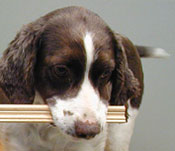Wood Balusters: Wood Offers Lots of Choices
Essentials of Wood Balusters: wood is a great material to use for railing balusters but as a consumer, one must understand some of its limitations, after all railings not only are a interior decorating element of your home environment, but also serve a very important safety roll. So here are a few ideas...
There are many styles of wood balusters. Wood selection should be tied to those designs, so lets first look at a typical baluster's anatomy, and discuss how the parts of your balusters & wood species selection issues might affect its construction.
Minimum Sizes:
 A-
this is a typical "dowel topped spindle". Obviously
so called, because the top of the railing spindle is turned
round. In Ontario, oak spindles (same for maple) must be a
minimum of 3/4" in diameter at this point (#1).
A-
this is a typical "dowel topped spindle". Obviously
so called, because the top of the railing spindle is turned
round. In Ontario, oak spindles (same for maple) must be a
minimum of 3/4" in diameter at this point (#1).
At #2: the lower dowel pin of your wood baluster is the same conversation. It must be a minimum of 3/4" when you are using oak spindles (likewise for maple spindles).. and for that matter any railing balusters must be a minimum of 3/4" in diameter anywhere down the length of the pattern.
If your choice is to use cherry or pine for instance then this is where your balusters wood choice would force you to "up size" your design. The minimum diameter for softwoods spindles in Ontario is 1" (important to check on YOUR local regulations).
B: this type of railing spindle is typically referred to as a "square topped spindle." The dictatorial "building code" states that in Ontario railing balusters must be a minimum of 1 5/16" square (at #3) if made from oak or maple. It your intent is to use poplar or white pine, as your wood of choice the size jumps to 1 3/4".
Most other species are not specifically outlined in the building controls manual, and local officials can and do, force you to get a engineer's stamp of approval BEFORE you proceed. Recent lawsuits involving staircase balusters have made municipal officials gun-shy and they are eager to shift liability to others.
Anything bigger is at your discretion, but always make sure that the railing and staircase balusters are purchased at the same time, to assure that one matches with the other.
Matching Handrailing:
Handrails are typically grooved to accept a particular square topped baluster. Wood tops then, must be machined to fit this groove. (ie. 1 5/16" baluster is designed for a 1 5/16" grooved handrail). If you are using dowel topped spindles this is not relevant, as the railing has no groove.
Lengths:
Spindles of say 5 years ago were usually 34", 36" & 38". Recent changes to the building code have increased the minimum height requirements making it necessary to source longer spindles.
Rarely today is there a place for any handrail balusters under 36" and in fact it is necessary to make your shopping list, separating what spindles are necessary for horizontal runs and which ones are needed for stairwells, either sitting on the individual steps or on top of the stringer. That way sales staff that are helping you to put together your shopping list, can break down your requirements to fit the application, adjusting length as necessary.
For spindles or balusters installed on steps you typically need a 38" long one for at the front of the step and a longer ~42" for at the back. Pitch of the steps does affect the exactness of the numbers at the time of installation but NOT enough to really change your purchasing requirements.
;
